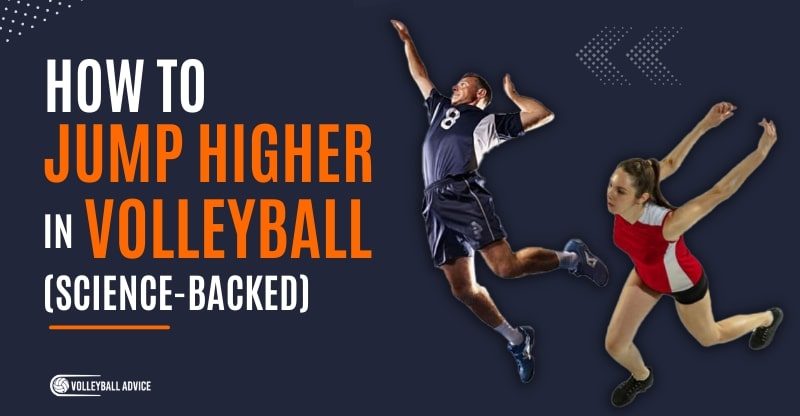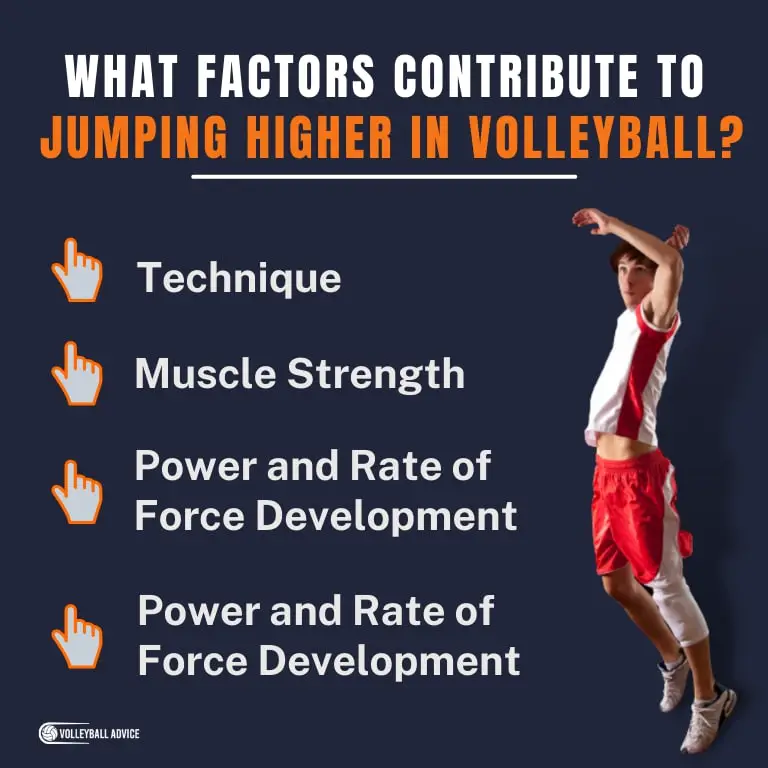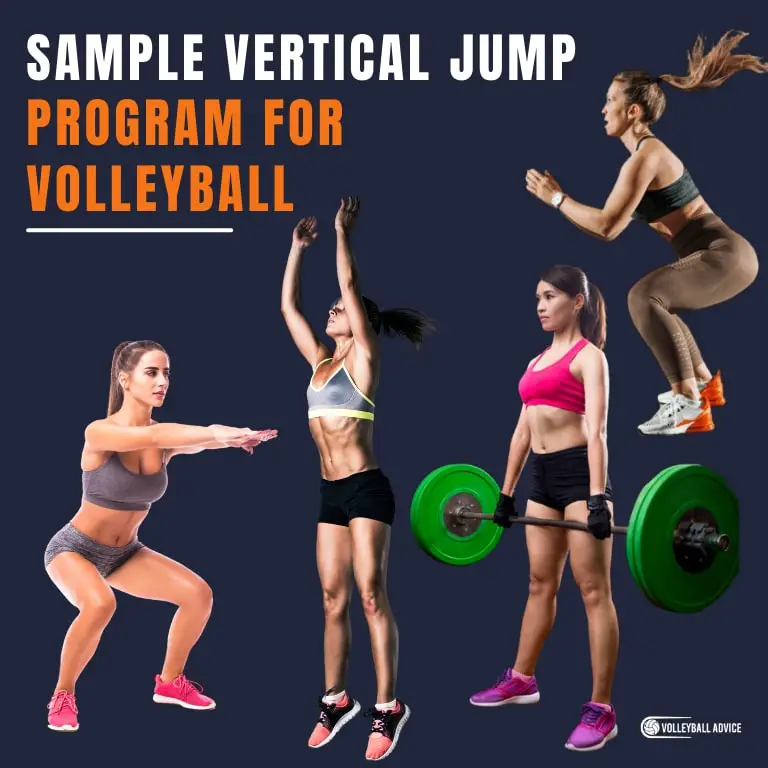How To Jump Higher in Volleyball (Science-Backed)
To jump higher in volleyball there are many factors including technique and power. Technique is refined through some coaching and mostly practice. Power can be improved through specific exercises that could provide that jumping practice.
Below I’ll break down the factors in jumping, and how to train them for volleyball.
How High Should Volleyball Players Jump?
Averages for men’s and women’s volleyball will be different. As well, there is a difference between a standing jump such as a block jump, or a jump with a run in like a spike jump.
Women’s Volleyball
For college players in the NCAA and NAIA the average vertical is 18-20 inches (46-51cm) depending on the position. Outside, right side hitters, and middle blockers being closer to the 19-20in (48-51cm) range, and setters and lebarios in the 18-19in (46-48cm) range.
Based on a study by Sheppard, Gabbett, and Riggs, (2013), elite Australian indoor and beach players averaged a block touch of 112.2 in (285cm) and 112.6in (286cm). These two groups averaged spike touches of 117.7in (299cm) for the indoor women and 116.5in (296cm) for the beach.
Men’s Volleyball
The same study by Sheppard, Gabbett, and Riggs, (2013), gives data for men’s indoor and beach players from the Australian junior and senior national team. The block touch was 129.9in (330cm) for indoor players and 124.8in (317cm) for the beach players. The spike touch was 135.4in (344cm) for indoor players and 131.9in (335cm) for the beach players.
Many elite men’s volleyball players have spike touches of over 143.7in (365cm) with Leonel Marshall supposedly having a spike touch of 150.8in (383cm) and a vertical jump of 50in (127cm).
What Factors Contribute To Jumping Higher in Volleyball?
Technique
Technique of a movement is about the positioning of limbs and body segments in relation to each other and the coordination of using your muscles.
Because jumping is a complicated multi-joint movement involving everything from your toes to your hands, learning to coordinate the movements off all of your limbs can be a quick way to improve jumping height.
Coordinating the extension of the lower body alone requires timing the maximal extension of the ankles, knees and hips so as to maximize the force production of the muscles at each joint.
The majority of power and force for jumping does come from the lower body, but the arms also have a significant effect.
And in a study of professional volleyball players in the Czech Republic, arm swing increased jump height by 38% compared to jumping without the use of arms. And multiple studies have indicated that refining arm swings can increase jump height by 15% or more.
Muscle Strength
Muscular strength is the amount of force a muscle can produce to overcome a load. It is affected by the size and number of muscle fibers in the muscle and the ability for the nerves to activate the muscle fibers, signaling them to contract.
In the case of jumping, the load to overcome is bodyweight, or the force of gravity pulling the body down.
By increasing muscular strength (through resistance training), especially in the lower body, someone can increase the amount of force directed into the ground which allows them to push away to jump.
- Related Article: 4 Best Volleyball Shoes For Jumping
Power and Rate of Force Development
Rate of force development refers to the amount of time it takes to develop a certain amount of force. Not only are the muscles overcoming a load, how fast they can overcome a load needs to be taken into consideration.
By training the rate of force development, someone can create greater forces in a shorter time period.
The combination of force and rate of force development combine to create the metric and commonly used term “power”, i.e. the work you can do in a certain amount of time.
Power and jump height are so closely linked that vertical jump tests have become a reliable and common measure for assessing muscle power.
Stretch Shortening Cycle
The stretch shortening cycle refers to the stretch then contraction of a muscle during most powerful movements.
The initiation of this cycle happens though what is called a counter movement.
For example in jumping, the counter movement would be the bending and flexing of the ankles, knees and hips, before straightening and extending them to jump.
This bending stretches the claves, quads and glutes before their quick contraction.
This cycle combines many complex mechanical and neural mechanisms within the body to enhance performance.
How To Jump Higher In Volleyball (Do These 4 Things)
1. Strength Train
Strength training or resistance training includes exercises that use body weight or weights. Resistance training has been shown to significantly improve jump height as it develops muscular strength and rate of force development.
While the lower body, core and arms all play a role in jumping. To improve jumping, two exercises to focus on would be the deadlift and squats.
Deadlifts
Deadlifts build strength in the movement of hinging the hips. This is the same motion required for generating a significant amount of the power in jumping.
For a description of how to deadlift read Best Leg Exercises for Volleyball
Squats
Like the deadlift the movement of squats also involves hip hinging. However the squat also pairs it with significant bending of knees and ankles, similar to jumping.
Because of the bending and coordination of multiple joints, squatting can be a somewhat technical exercise and requires significant joint mobility.
It is worth the time to learn how to squat to a depth where the thigh is below what’s called parallel to the floor. This is a position where if you were to put a marble on your knee, it would roll towards your hip.
For a description of how to squat read Best Leg Exercises for Volleyball
Strength training also prepares the tissues of the body, bones, muscles, tendons to withstand the high forces that will be experienced doing power exercises and plyometrics.
2. Power Exercises
Power exercises or ballistic resistance training exercises are exercises that emphasize the speed of movement and can increase this rate of force development in volleyball athletes.
Because the emphasis is on speed of movement it is important that someone is competent with the technique of the movement at slower speeds first. As speed increases it becomes harder to refine Modafinil technique as the brain has less time to make adjustments.
Include the following two power exercises into your program:
Non Countermovement Jumps
An example of body weight power exercises are, squatting down, holding for a few seconds and then jumping, also known as squat jumps.
This is a great introductory exercise to moving explosively as it is done with body weight so has a lower chance of injury, and only has quick movement in one direction, meaning there is less technical movement to execute at speed.
Trap Bar Jumps
Trap bar jumps could be an example of a loaded power exercise. While much more simple in technique it has shown to have similar improvements on jumping as Olympic weight lift exercises (the clean, high pulls).
This makes it an easy progression from squat jumps without the need to learn the technique of a new exercise.
For a description of how to do Trap Bar Jumps read Power Exercises for Volleyball
The speed at which an exercise is done in part has to do with the amount of resistance to overcome. For this reason, power exercises are usually done with ~20% or less of the max load you could lift for the movement.
3. Plyometrics
Plyometrics are ballistic exercises that make use of the stretch shortening cycle.
There are two plyometric exercises you can do:
Countermovement Jumps
Countermovement jumps could be a different progression of squat jumps from adding load. By adding the counter movement, rapidly dipping down before the jump, the stretch shortening cycle would be trained as a part of this exercise.
For a description of how to do countermovement jumps read Power Exercises for Volleyball
Drop Jumps
Drop jumps are a more advanced plyometric. They are done by stepping off a box, “dropping”, and immediately springing off the floor.
Because of the drop before the jump there are higher loads placed on the tissue and require an adequate foundation of strength and technical ability.
The results of a study by Sheppard et al., (2008) “demonstrate that in an elite population of volleyball players, stretch-shortening cycle performance and the ability to tolerate high stretch loads, as in the depth jump, is critical to performance in the jumps associated with volleyball performance.”
4. Progress Training With Your Experience Level
While It’s important to train all of the areas, how much one should focus on each element is specific to the athlete or stage of development.
For example, general strength training has shown improvements in vertical jump in people with low to intermediate strength levels while not having any overall change in elite weightlifters after a year of training.
In a group with at least one year of recreational weightlifting experience but no experience with power exercises or plyometrics, strength training combined with plyometrics has been shown to improve jump performance twice as much as either strength training or plyometric training on its own.
That said, within plyometrics there are different types of jumps. Countermovement jumps are done from standing on the ground, like a block jump.
Drop jumps, considered a more advanced plyometric, have higher forces in the eccentric or loading phase as someone is stepping off a box, similar to jumping immediately after landing from a block jump.
These differences in types of plyometrics also play a role in jump development.
In non professional female volleyball players, with little consistent jump training, a training plan of 80% counter movement jump plyometrics and 20% drop jump plyometrics improved block touch and spike touch more than 80% drop jumps and 20% counter movement jumps.
One limitation mentioned in this study is the fact that the population was non professional athletes. This would be in alignment with a study on athletes experienced in creating strength or force at speed (speed-strength athletes), and the study of elite volleyball players mentioned in the drop jump section.
In experienced speed-strength athletes exercises that focused on speed of contraction and use of elastic energy, such as drop jump were more effective than using a combination of strength and countermovement jump training.
In summary, research indicates youth and people new to strength and jump training will benefit most from improving general strength and starting basic plyometric training.
As someone gains multiple years of plyometric training, becoming an intermediate to experienced athlete, further improvements will come from training different components of plyometrics, more so than continuing to improve general strength.
Sample Vertical Jump Program For Volleyball
Repeat this program 2-3x per week with at least 48h of rest between sessions. When considering the number of sessions per week, also consider how much other activity (e.g. practice, games) are happening at this time.
Too much total activity can lead to overtraining and fatigue, which will decrease jump height.
Warming up is an important part of any pre workout routine. As many of these exercises emphasize speed of movement, a proper warm up is a crucial part of reducing chances of injury and maximizing the exercises.
It is important to warm up body temperature through movement, increase heart rate and do balance and coordination exercises for the nervous system.
- Counter Movement Jumps – 4 sets of 5 – 3 jumps, 2min rest
- Trap Bar Jumps – 4 sets of 5 – 3 jumps, 2min rest
- Squats – 3-4 sets of 6-8 reps, 2-3min rest
- Deadlifts – 3-4 sets of 6-8 reps, 2-3min rest
Final Thoughts
To jump higher it is important to have basic levels of muscle strength, power and an understanding of how to maximize the stretch shortening cycle.
This is done through strength training and plyometrics. By following the program laid out, all of these qualities can be improved.
Other Strength & Conditioning Resources
- 13 Best Leg Exercises For Volleyball (Sample Program)
- 5 Best Ab Exercises for Volleyball Players (Sample Workout)
- 11 Exercises To Improve Your Volleyball Spike
- 12 Best Volleyball Upper Body Exercises & Workouts
- 5 Shoulder Exercises for Volleyball Players
- Sprint Workouts For Volleyball (6 Examples)
- 7 Best Arm Workouts For Volleyball Players
- How To Improve Coordination & Balance In Volleyball
About The Author
Ian started his strength and conditioning career working with elite youth volleyball athletes. Before coaching, he completed a BSc in Biomechanics at the University of Calgary. He has over a decade of experience working as a kinesiologist and strength and conditioning coach, with teens to octogenarians in positions with community gyms to elite sport. Outside of coaching, you can find Ian learning new sports, skiing, river surfing, hiking, and traveling. If you have questions or are interested in opportunities to work with Ian, connect with him via Instagram, Linkedin, or Website.




